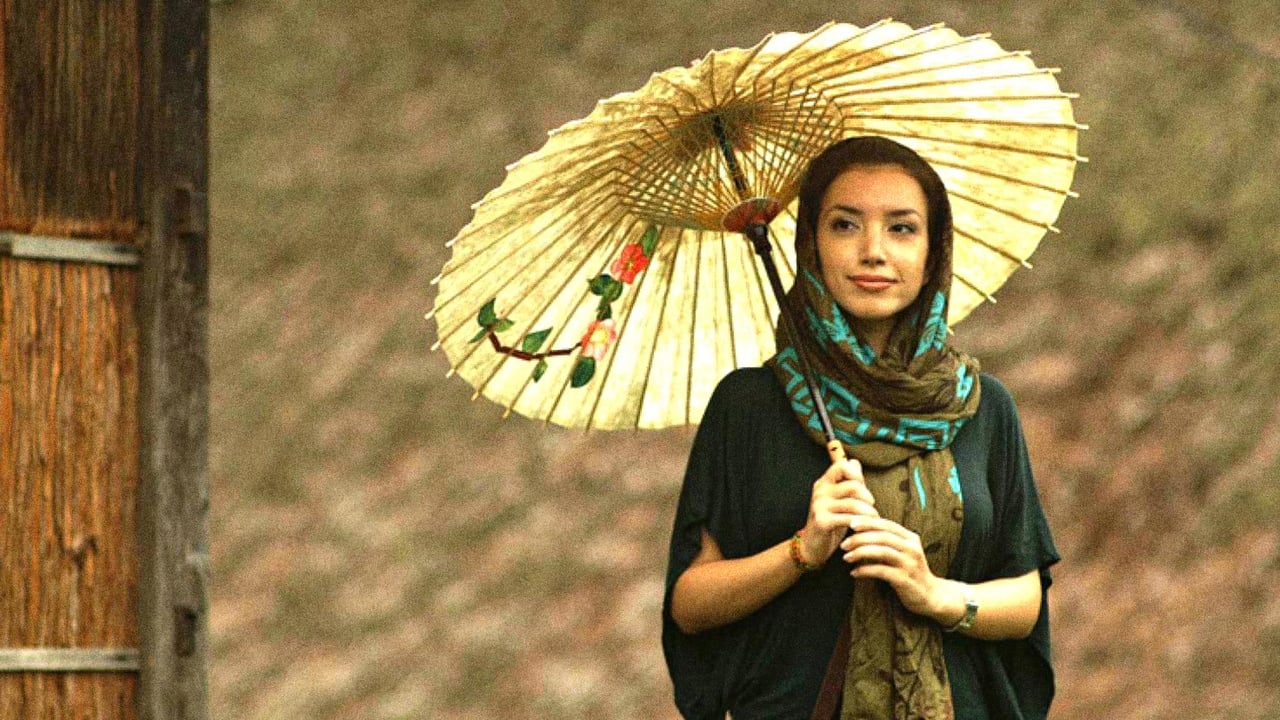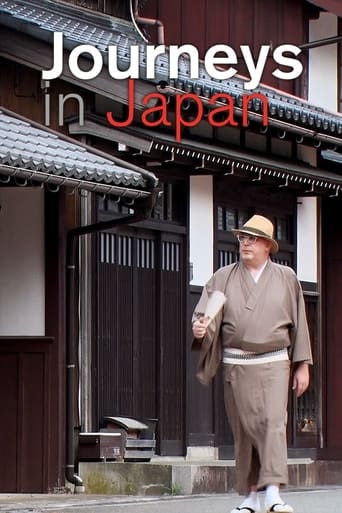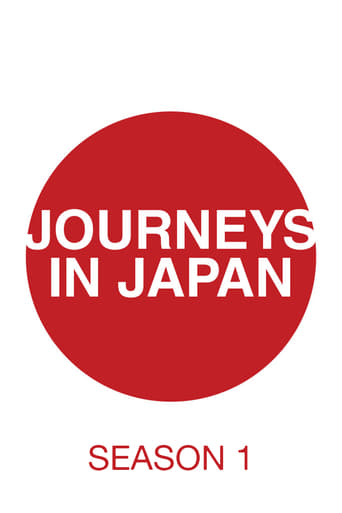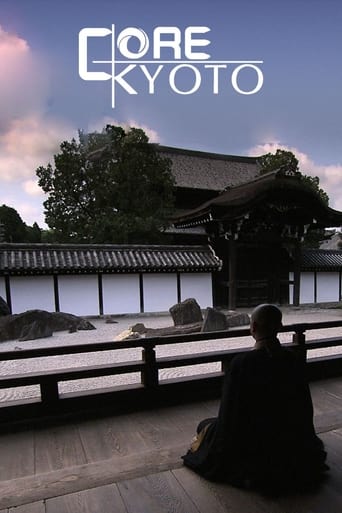Journeys in Japan Season 10

Journeys in Japan provides an eye-opening look at the many unique places to visit in Japan. English-speaking visitors travel the length of the country, exploring the culture, meeting the local people, visiting historic sites and offering travel hints rarely found in guidebooks.
Watch NowWith 30 Day Free Trial!
Journeys in Japan
2010 / TV-G
Journeys in Japan provides an eye-opening look at the many unique places to visit in Japan. English-speaking visitors travel the length of the country, exploring the culture, meeting the local people, visiting historic sites and offering travel hints rarely found in guidebooks.
Watch Trailer
Journeys in Japan Season 10 Full Episode Guide
Mt. Myogi, located in western Gunma Prefecture, is famous for its unusual rock formations and beautiful autumn foliage. At a little over 1,000 meters, it's not high, but has fun courses, some which require advanced skills, making it a popular with climbers. Since the mountain has been worshipped from ancient times visitors can also enjoy the area's historic atmosphere, including an ancient highway. Our reporter explores Mt. Myogi, with the highlight coming at the end when she climbs a towering T-shaped rock.
Osaka is the largest city in western Japan. The 16th-century warlord Toyotomi Hideyoshi, who unified Japan after a long period of civil war, chose it as his power base and built a castle there to serve as the power base for his clan. In the years that followed, Osaka became a major logistical and economic hub. From the mid-19th century, Osaka rode the wave of Japan's modernization and the city expanded rapidly. The development of its spinning industry brought prosperity. During this period it was known as "Great Osaka" and saw the construction of many handsome commercial buildings, several of which survive to this day. From the late 1940's, the city was a driving force for Japan's postwar reconstruction and rapid economic growth. In 1970 it became the first city in Asia to host a world's fair, known as Expo '70. On this episode of Journeys in Japan, American architect James Lambiasi visits Osaka and explores its history and culture, as reflected in its impressive architecture.
Nanyo City lies in Yamagata Prefecture, in the Tohoku region north of Tokyo. The city is focusing on boosting tourism for visitors with disabilities. Wheelchair influencer Ryoko Nakajima visits Nanyo together with US-born TV talent Michelle Fujisaki, to enjoy the barrier-free facilities. They harvest fruit, visit a hot-spring hotel and listen to local folk tales. Then, using special equipment, Ryoko tries paragliding assisted by an experienced instructor.
Ise City is in southeastern Mie Prefecture in Central Japan. It is home to one of Japan's most sacred sites, Ise Jingu Shrine. For hundreds of years it has welcomed pilgrims from all over the country. This has nurtured many traditions, such as the tasty confectioneries it offers to travelers and crafts that serve as souvenirs. Jennifer Julien from France takes in the most important rituals of the year, and experiences the culture that was cultivated over time through Ise worship.
Iwamizawa is located about 40 minutes by train from Sapporo in Hokkaido Prefecture. It flourished as a transportation hub for coal, but spiraled into decline following the closure of the mines in the 60's and 70's. However, blessed with vast farmland, Iwamizawa was able to transform itself into a leading agricultural district in Japan. These days, people from across the country are migrating to the area where the miners once lived, sparking a new movement. On this episode of Journeys in Japan, Kyle Card from Canada meets people bringing a new vitality to Iwamizawa.
The Kishiwada Danjiri Festival is one of the most vibrant and spectacular festivals in all of Japan. Over 2 consecutive days, ornately decorated floats known as Danjiri are pulled through the streets at high speed by teams of over 200 men. The wheels on the Danjiri floats are fixed straight ahead, so they cannot be steered like a car, but the teams pulling them skillfully maneuver the floats around corners. Drawing on their expertise, experience, and bravery, they even put their lives at risk. These thrilling turns are the highlight of the festival. David Pavlina is from the United States. He visits Kishiwada to watch the Danjiri Festival and meet the people taking part. He also visits a local furniture store to discover the traditional craftsmanship, and samples some of the street foods that are popular in this region of Osaka Prefecture.
The Katsura River runs through a beautiful valley in Yamanashi Prefecture, not far from Tokyo. Fed by springs from Mt. Fuji and the surrounding area, the river is known for the clarity and volume of its water. This episode of Journeys in Japan introduces fun ways to enjoy the Katsura River, such as rafting, tubing, traditional angling, and Sawanobori (river climbing), making it the perfect getaway from the muggy midsummer heat of downtown Tokyo.
The Nakanojo Biennale is an art festival held in beautiful Nakanojo in Gunma Prefecture. It boasts one of the largest artist-in-residence programs in Japan, with creators from all over the world gathering in this small town to work on their site-specific pieces. With world-class contemporary art installations, the festival draws large crowds during its one-month run. Historically known as a hot spring town, Nakanojo has many cultural events passed on to today. Belgian art and fashion PhD candidate Saskia Thoelen discovers how contemporary art has transformed a rural town that also reveres tradition.
Kotohira, in western Kagawa Prefecture developed around the famous shrine complex known as Kotohira-gu. Some 2-million tourists visit annually from all over the world. In the olden days, pilgrims who came from around the country, bought Uchiwa paper fans as souvenirs, and enjoyed eating the local specialty Sanuki noodles. Shizuka Anderson from Canada, experiences the culture of hospitality that developed around these pilgrimages.
Rausu lies on the coast of the Shiretoko Peninsula, in eastern Hokkaido Prefecture. Most of the peninsula is designated as a national park, to preserve its rich natural environment. Tours by boat offer visitors the opportunity to see orcas and whales, as well as brown bears on the seashore. The fertile waters off Rausu also provide abundant catches of many kinds of fish. One of the main specialties of this area is kombu (kelp seaweed), an essential ingredient that adds flavor and umami to the dashi stocks that underpin Japanese cuisine. Rausu kombu is considered some of the finest in Japan and is in strong demand from high-end Japanese restaurants around the country. The harvest takes place from late July through the end of August. On this episode of Journeys in Japan, British photographer Alfie Goodrich visits Rausu and meets the kombu harvesters. He also goes to observe the wildlife that proliferates on the peninsula.
The Michinoku Coastal Trail, which was launched by the Environment Ministry, is a long trail along the Pacific coast that crosses 4 prefectures from Aomori Prefecture, in the north, to Fukushima Prefecture, in the south. Canadian actor, Kyle Card walks a stretch connecting 3 villages in Iwate Prefecture to get a feel of Tohoku's landscape and see how the local people are stepping forward and recovering from the 2011 Great East Japan Earthquake.
The Izumo region in Shimane Prefecture, where deities from across the country are said to gather annually for a meeting, is closely linked to the gods. On this episode of Journeys in Japan, our reporter explores the home of Japanese mythology, visiting a workshop that makes one of the largest Shimenawa sacred ropes for the Izumo Grand Shrine and meeting local residents producing unique works of folk art as offerings to the gods. Jaime Lopez, a wire artist from Chile, takes a close look at the connection between the people of Japan and their gods.
Muroran, in southwestern Hokkaido Prefecture, flourished as an industrial city, mainly in steel manufacturing. After the 1970's, the city declined with industrial sector changes and other factors. But in recent years, tourism is up with popular night factory viewing, retro architecture touring as well as dolphin and whale watching. British photographer Alfie Goodrich discovers Muroran's wonderful people and photogenic charms.
Sawara lies in northeast Chiba Prefecture, around 70 kilometers to the east of Tokyo. Thanks to its location on a tributary of the Tone River, by the 18th century it had become a prosperous center for freight transportation. For some 300 years, Sawara has held festivals twice a year, in July and October. Backed by rich merchants, these developed into major events, featuring 24 large and lavish floats. The festivities have now been registered as a UNESCO intangible cultural asset. On this episode of Journeys in Japan, Saskia Thoelen discovers the excitement of the Sawara Grand Festival, and meets the craftsmen and neighborhood residents who make it happen.
Rising above the highlands of central Japan, Mt. Hakusan (2,702 meters) is considered of the most sacred peaks in the country. Since ancient times, it has been venerated as the home of the Shinto deities and a paradise of the Buddha. To this day, there is a shrine at the foot of the mountain dedicated to the worship of Mt. Hakusan, with its inner sanctum on the actual summit. The trails to the peak follow ancient pilgrimage routes, which have been carefully maintained since ancient times. Close to the top, there are wild meadows filled with alpine plants that decorate the slopes with their colorful blooms in early summer. On this episode of Journeys in Japan, Australian photographer Peter Skov delves into the sacred traditions, climbs to the summit, explores the wild nature on the mountaintop, and discovers its natural splendor.
On this episode Charles Glover, an actor from the United States, visits the Tonami Plain in Toyama Prefecture, known for its vast farmlands, especially rice fields. He gets a glimpse into the way of life in a farming village, where people have long lived in harmony with nature. He learns about how the old community is preserving traditions, and architectural heritage, by inviting in people from around Japan to take up residence. His simple, yet charming, journey ends with a spectacular festival.
The Hachimantai Plateau straddles the border of Iwate and Akita Prefectures. A large area around its summit is covered by wetlands and during the warmer months, from June onward, these marshes turn into a garden of alpine flowers, attracting visitors from near and far. The Hachimantai region also boasts a wealth of hot springs. There are various ways to enjoy this gift of nature, such as by relaxing in a Rotenburo (open-air bath), while enjoying the view. Or you can enjoy Ganban-yoku, lying down on the warm rocks, soaking in the heat that emanates from the earth. In this area, people like to book into hot spring facilities for long-term stays of a week or more. This system, known as "toji," has long been popular among farmers who come to rest and ease their fatigue in the off-season.
Japanese green tea is produced from tea leaves that are steamed and then dried, unlike black tea, for which the leaves are first fermented. Shizuoka Prefecture is the largest tea-growing region in Japan. Various kinds of green tea are produced there, according to the ways in which it is grown and processed. On this episode of Journeys in Japan, American actress Ananda Jacobs visits Shizuoka during the peak tea harvesting season. She delves into the history of the region, to find how tea came to be such an important industry. And she meets the people who devote their lives to producing this remarkable drink.
Nishi-izu, with stellar views of Mt. Fuji, is located on the western coast of the Izu Peninsula. Geopark sites with strata formed by an undersea volcano are reachable on foot or by boat. The neighboring town of Matsuzaki is known for its beautiful townscape featuring buildings with distinctive Namako plaster walls. Kote-e artworks created with plaster by Matsuzaki craftsman-turned-artist, Chohachi Irie, are also a must-see in this town. Matsuzaki is the largest production region of salt-pickled sakura leaves. We visit people in the industry and hear about the appeal of the leaves. On Journeys in Japan, traveler Leina Bambino explores the culture nurtured in a small port town and the beauty of Nishi-izu.
Yamaguchi Prefecture lies in the far west of Japan's main island, Honshu. It has numerous landscapes that are unlike any other part of Japan: a limestone quarry evoking a giant ancient amphitheater; an underground cave system with intricate stalactites and stalagmites; a tiny island where the village boasts traditional walls of stone and plaster; and many more. American actor Charles Glover visits Yamaguchi to take in these magnificent, distinctive views and to discover the stories that underlie them.
Uchiko, which is 700 kilometers southwest of Tokyo in Shikoku's Ehime Prefecture, flourished as a pilgrimage post town on an ancient highway. In the city center, Machiya residences have been carefully preserved. Australian actor, Luke Bridgford explores historic Uchiko, discovering its traditional architecture and candle craft, as well as an ancient kite festival in which he participates in a sky battle.
Hieizan (Mount Hiei) rises high to the northeast of the city of Kyoto, straddling the border between Kyoto and Shiga Prefectures. It is one of the most sacred Buddhist sites in Japan, and has been a focus for people's faith for over 1,200 years. The precincts of Enryakuji temple cover the entire mountaintop, and to this day many priests live there, undergoing spiritual training. Peter MacMillan is a researcher of Japanese literature from Ireland. On this episode of Journeys in Japan, he visits Hieizan to explore the deep spiritual connection that people feel for this sacred mountain.
Iga, in the northwest of Mie Prefecture, is famous as a place where many ninjas lived, especially in the late 15th to 16th centuries. At that time, the Iga ninjas worked as mercenaries for feudal lords in the surrounding areas. They used their secret techniques in performing acts of espionage and clandestine attacks. There are still many sites in Iga that evoke those days, such as the Ninja Museum and the site of the fortress where they fought a huge army. On this episode of Journeys in Japan, Jennifer Julien visits Iga and meets modern-day ninjas who are keeping the ancient tradition alive.
Tateyama is only 80 kilometers from Tokyo, in southern Chiba Prefecture. Off Tateyama spreads a bountiful sea that offers fresh seafood. Recently, the waters have been attracting attention from around the world as a place for cool diving adventures. On Journeys in Japan we explore Tateyama's wondrous underwater world.
John Moore, from Ireland, is a social entrepreneur. Euan Craig, from Australia, is a potter. The men take off on a road trip around western Miyazaki Prefecture, in Kyushu. They get a glimpse into the local life in the mountainous village of Shiiba. And in the city of Ebino, they learn about the simple, ancient worship of a rice deity called Tanokansa.
The Oku-Echizen district lies deep in the mountains of Fukui Prefecture, inland from the Sea of Japan coast. The central city of this region is Ono, which first developed as a castle town from the second half of the 16th century. The streets around the castle were laid out in the form of a grid, and even today the town retains the same street plan, with many traditional buildings still to be seen. Ono is also blessed with abundant underground water from the nearby Hakusan mountain range. Neighboring Katsuyama City is the site of a former religious complex that used to be one of the largest in Japan. Excavations are still continuing there to reveal its history. On this episode of Journeys in Japan, Mai Rapsch from Germany meets the people of Oku-Echizen and discovers the way they live, co-existing with the world of nature and deeply immersed in their religious faith.
Minami-Uonuma, in southern Niigata Prefecture, is one of Japan's snowiest regions. Suzuki Bokushi's Hokuetsu-seppu, which describes people's lives there, was published 180 years ago. The book serves as a guide for Australian Jonathan Senior as he explores traditional weaving of a hemp textile and a wild festival passed down since ancient times, as well as the area's distinctive snow culture.
Japow refers to Japan's world-famous powder where skiers delight in making tracks in heavenly virgin snow. An ideal place for this in central Hokkaido Prefecture ... on Mount Asahidake and Mount Sandanyama in the Daisetsuzan mountain range. Slovenian Cveto Podlogar, an international mountain guide, rides the powder along with local, professional skier Ken Fujikawa. They glide through Japow knee-deep, sending powder flying in the air.
Iojima Island lies around 1,000 kilometers southwest of Tokyo, off the south coast of Kyushu. Its main peak is Mt. Iodake, a volcano that remains very much active. The island has a population of slightly over 100 people, most of whom live close to the port, just three kilometers from the volcano. On this edition of Journeys in Japan, Shizuka Anderson from Canada explores the beautiful yet harsh natural environment, discovers the island's distinct culture, and meets many of the people who are living life to the full on this island of mystery and imagination.
Okinawa, Japan's southernmost prefecture, has developed a distinct architecture all its own, reflecting its subtropical setting and often harsh climate, as well as historical influences from mainland Japan and other countries, such as China and the United States. On this edition of Journeys in Japan, American architect James Lambiasi visits some of Okinawa's most notable buildings. He meets the local people and discovers the complex history that underlies its enduring culture.
The city of Kikuchi, in northern Kumamoto Prefecture in Kyushu is known for its prosperous agriculture and livestock industries. Here, natural farming, which eschews fertilizers and agricultural chemicals, is widely adopted. On this edition of Journeys in Japan, Mai Rapsch from Germany experiences the lifestyle of people living in harmony with nature… in a beautiful part of the country of course.
Iheya is the northernmost island of Okinawa Prefecture and takes an hour and twenty minutes by ferry from a port in the north of the main island. Approximately 35 kilometers in circumference Iheya has a population of about 1,100. Untouched by large-scale tourism development, the natural environment and people's lives have remained little changed. Our reporter takes a winter break on the remote island where he fishes for young octopus in the low tide at night, goes on a jungle and village run with locals and tourists, and makes tofu with seawater at a home inn…simple and unforgettable experiences.
Lake Biwa is the largest lake in all of Japan. In winter, its remote northern coast is a place of unspoiled peace and silence. Since the old days, the local people have carefully preserved their places of worship, and their traditional handicrafts. On this edition of Journeys in Japan, Charles Glover follows an ancient highway, to discover an area of almost timeless calm.
Tottori Prefecture ranks number one in Japan when it comes to crab hauls. It's also the largest consumer of the seafood. The prized snow crab, called Matsuba locally, is especially popular as is the less expensive snow crab. Many tourists visit the prefecture to savor them during winter-the best season. On this episode, our reporter Daniel Woolpert enjoys the winter delicacy in various ways ranging from an all-you-can-eat lunch to a refined multi-course dinner. He also enjoys a relaxing dip in a snowy open-air hot spring and strolls around a shopping street that draws customers with manga characters.
Nichinan city, situated in Miyazaki Prefecture in southwestern Japan, once prospered from fisheries and forestry. Aburatsu, which is a major district along the sea, flourished as a port town. But the area declined when the fishing industry collapsed. The Aburatsu shopping arcade also suffered through competition from a large shopping complex and depopulation in the 1980s. Many of the arcade's shops closed their shutters. But in 2014, a team was formed to revitalize the retail area and many vibrant spaces opened up. On Journeys in Japan, Kyle Card from Canada meets locals who have been creating appealing new businesses as well as community spirit.
Yuzu is a variety of citrus fruit that has long been prized for its superb aroma. A winter specialty, it is an essential ingredient in Japanese cuisine. The Chugei district, in the east of Kochi Prefecture, produces more yuzu than anywhere else in Japan. This area used to depend on timber - it was the most important source of lumber in western Japan. But the forestry industry declined after World War II, so people in Chugei turned to cultivating yuzu trees instead. On this edition of Journeys in Japan, David Wells visits the area to discover the magic of yuzu. He meets the local people who grow the fruit, and explores the villages where this special citrus is an essential part of people's daily lives.
The town of Kamioka lies in the mountains of central Japan. It was once famous as a major center for mining. Now the mine is closed, but these days the area has become a center for a new and unusual style of tourism - on mountain bikes that run along the tracks of a disused railroad. On this edition of Journeys in Japan, Dean peddles through beautiful mountain scenery to explore a town that still retains its old-school atmosphere. Finally he arrives in a mountain village where people still follow their traditional, age-old way of life.
Free Trial Channels
Seasons









































